Abstract
This paper presents an innovative approach towards the development of a green concrete. The geopolymer is an environmentally friendly construction/repairing material. In addition, glass fibers are helpful to influence the strength properties and to reduce hair line cracks and bleeding in concrete. This study is based on the use of fly ash and glass fibers as a partial replacement of cement and, subsequently, its effect on compressive strength and split tensile strength of concrete. The geopolymer is manufactured after the process of geopolymerization between class F fly ash and alkali activator fluid (sodium silicate and sodium hydroxide). In geopolymer concretes (GPC), an inorganic polymer called aluminosilicate will act as a binder, the same as conventional concrete has Portland cement (OPC)-generated C-S-H gel. The glass fibers are added in the ratios of 3%, 6%, and 10% by weight of cement. To check the effect of geopolymer and glass fibers on compressive strength and split tensile strength of concrete, concrete cubes of size 150 × 150 × 150 mm and concrete cylinders of size 150 × 300 mm with or without geopolymer and glass fibers were casted and cured for 7, 14, 21, and 28 days. The compressive strength and split tensile strength of all concrete cubes and cylinders were determined by compression testing machine. The findings of the research study revealed that concrete having geopolymer and glass fibers used as a partial replacement of cement showed lesser strength as compared to conventional concrete. Concrete having glass fibers showed reduced workability and more segregation as compared to geopolymer concrete and normal concrete. However, the concrete made either with geopolymer or glass fibers is economical as compared to conventional concrete.
1. Introduction
Concrete is one of the most widely used construction materials; it is usually associated with Portland cement as the main component for making concrete. Due to rapid urbanization and industrialization, there is a need for large infrastructural development, which is why utilization of concrete as a construction material is increasing day by day. It is estimated that the production of cement was increased to about 4.4 billion tons in 2021 [1]. Concrete is used globally to build buildings, bridges, roads, runways, sidewalks, and dams. Cement is indispensable for construction activity, so it is tightly linked to the global economy. Cement production is growing by 2.5% annually and is expected to rise from 2.55 billion tons in 2006 to 3.7–4.4 billion tons by 2050 [2]. Cement manufacturing requires extreme heat for its production. Producing a ton of cement requires 4.7 million British thermal units (BTUs) of energy, equivalent to about 400 pounds of coal, and generates nearly a ton of CO2. Due to the high emissions and critical importance to society, cement is obviously responsible for increasing greenhouse gas emissions. The production of cement releases greenhouse gas emissions both directly and indirectly: the heating of limestone releases CO2 directly, while the burning of fossil fuels to heat the kiln indirectly results in CO2 emissions. The direct emissions of cement occur through a chemical process called calcination. Calcination occurs when limestone, which is made of calcium carbonate, is heated, resulting in the breaking down into calcium oxide and CO2. This process accounts for almost 50% of all emissions from cement production.
The high ash content (30–50%) of the coal in the world makes this problem more complex. Safe disposal of the ash without adversely affecting the environment is also a major challenge. Hence, attempts are being made to utilize this fly ash rather than dump it. The coal ash can be utilized in bulk in geotechnical engineering applications, such as construction of embankments, as a backfill material, and as a sub-base material. Fly ash is a byproduct of electricity generating plants using coal as fuel. During combustion of powdered coal in modern power plants, as coal passes through the high temperature zone in the furnaces, the volatile matter and carbon are burned off, whereas most mineral impurities, such as clay, quartz, and feldspar, will melt at high temperatures. The fused matter is quickly transported to lower temperature zones, where it solidifies as spherical particles of glass. Some of the mineral matter agglomerates to form bottom ash, but most of it flies out with the flue gas stream and thus is called fly ash. The ash is subsequently removed from gas by electrostatic precipitators. The fly ash is a waste product of coal. Besides the use of fly ash in geotechnical applications, its use in concrete to produce greener concrete was also undertaken in the past [3].
There is no harmful effect of geopolymer concrete used in structural members on load carrying capacity, and the same standard codes are used for the design of geopolymer concrete as used for conventional concrete [4]. Geopolymer is a Portland-cement-free concrete and is a useful alternative to normal Portland cement concrete. It is useful for reducing the carbon footprint and has better performance in terms of structural behavior and durability [5]. Geopolymer concrete has high compressive strength at a low elevated temperature, low to medium chloride ion penetration, and high resistance to acid attack and abrasive forces [6]. The inclusion of fly ash and silica fume in geopolymer concrete is helpful for improving sustainability and reducing the cost of geopolymer concrete [7]. It is concluded that geopolymer concrete with or without steel fibers has better durability properties as compared to conventional concrete [8].
The inclusion of 1% to 2% glass fiber content in concrete is suitable for reducing shrinkage cracks, improvement in flexural toughness, and temperature resistance of light-weight concrete [9]. Inclusion of glass fibers is helpful for enhancing the split tensile and flexural strength of normal and recycled aggregate concrete. There is no significant effect of glass fibers on the compressive strength of normal and recycled aggregate concrete [10]. It is estimated that the use of FRP bars in concrete columns contributed 10% column capacity, which is very close to the capacity provided by steel bars, 12%; hence, they are suitable for compression members [11]. There is significant improvement in the flexural strength of polymer composites having glass fiber and polyester contents [12]. The strength and durability properties of concrete can be improved after the addition of glass fiber content up to 1%. Beyond 1%, a strength decrease takes place rapidly [13].
The use of fibers in concrete has increased in building structures because the fibers in concrete may improve the toughness, flexural strength, tensile strength, and impact strength of concrete. Glass fibers have various applications in concrete, such as crack control, preventing coalescence of cracks, and changing the behavior of materials by bridging the fibers across the cracks. Glass fibers used in concrete are of several types, such as E-glass (polyethylene glass fibers), P-glass (polypropylene glass fibers), O-glass (woven roving glass fibers), and AR glass (alkali resistance glass fibers) [14].
The basic purpose of using glass fibers in concrete is to provide reinforcement in concrete. The fibers are the main load carrying components, and their desired locations and orientations are maintained by a surrounding matrix, acting as a load transfer medium between them and protecting them from any damage caused by the external environment. Alkali-resistant glass fibers are mostly used in concrete as a reinforcement because of their resistance against alkali attacks caused by Portland cement [15].
In this research, the comparison of the strength properties, such as compressive strength and split tensile strength of concrete with or without geopolymer and glass fibers, will be carried out. The main purpose of this research is to investigate the suitability of the use of geopolymer and glass fibers in concrete to check whether there is some positive effect on concrete strength or not as there is a need to produce greener concrete nowadays to save natural resources and to conserve energy.
2. Literature Review
A polymer concrete is an innovative construction material that is produced by the chemical action of inorganic molecules. Fly ash, which is a by-product of coal obtained from a thermal power plant, is also available around the globe. Fly ash is rich in silica and alumina and, when reacted with alkaline solution, resulted in the production of aluminosilicate gel that can be used as a binding material for concrete production in place of ordinary Portland cement (OPC) [16]. The chemical composition of the geopolymer material is identical to the natural zeolitic materials, but the microstructure is amorphous. Any material that contains silicon (Si) and aluminum (Al) in amorphous form may be used as a possible source material for the manufacture of geopolymer suitable to produce concrete [17]. A study on the properties of fly-ash-based geopolymer M20 grade concrete was conducted, and the results indicated that the geopolymer can be used as an alternate binding material in place of cement to produce economical concrete [18]. The results of research work conducted on geopolymer concrete prepared by mixing sodium silicate and sodium hydroxide with processed fly ash subjected to curing at different conditions and different temperatures indicated that, with an increase in temperature, the strength of geopolymer concrete decreased, and geopolymer concrete made at 1200 °C had the least strength as compared to concrete made at a lesser temperature [19]. Oven-cured geopolymer concrete specimen provides the higher compressive strength as compared to direct sunlight curing. It was also observed that geopolymer concrete is a more advantageous, economical, and eco-friendly method when compared with conventional concrete [20]. With proper proportioning of total aggregate content and ratio of fine aggregate to total aggregate, along with the optimum values of other parameters, it has better engineering properties as compared to ordinary cement concrete [21]. Due to its better application, it is suitable for various civil engineering infrastructures [22]. Due to the higher concentration of sodium hydroxide solution, geopolymer concrete has high compressive strength, has easy handling to about 120 min, little drying shrinkage, and low creep. In addition, geopolymer concrete has excellent resistance to sulphate attack [23].
The results showed that no significant change was observed in water permeability coefficient for the geopolymer with different parameters [24]. It was also observed that there was a good correlation between the rheological parameters and slump for fly-ash-based geopolymer concrete incorporating plasticizer and super plasticizer [25]. Geopolymer concrete production results in environmental protection due to recycling of waste by products obtained from industries into a high value construction material needed for infrastructure development [26]. The geopolymer concrete has higher bond strength than ordinary concrete, as depicted by the pull out test conducted on both types of samples. The existing equation used for the calculation of bond strength of “reinforced” concrete can be equally applicable for geopolymer concrete [27]. Geopolymer concrete can be used as an alternative for Portland cement in various construction applications for infrastructure development [28]. Geopolymer concrete has better performance in acidic and basic environments due to its better durability, higher strength, and excellent volume stability as compared to ordinary concrete [29]. For the structural elements subjected to external restraints, the geopolymer concrete has an excellent advantage over ordinary concrete due to its low heat of hydration and shrinkage and high tensile strength [30].
The geopolymer concrete has excellent applications in precast concrete members in terms of cost and sustainable development [31]. The flexural strength and elastic modulus of geopolymer concrete can be easily determined using the equation provided by ACI 318-08, the same as in the case of ordinary Portland cement concrete [32]. Incorporation of geopolymer fibers improves the ductile nature of concrete suitable for structural performance for the infrastructure development [33]. In order to develop significant strength of geopolymer concrete, high temperature curing and extended curing time are preferred [34]. The type of application of geopolymer materials is determined by the chemical structure in terms of the atomic ratio of silicon and aluminum in the polymer material [35]. The polymer materials were found suitable for use in concrete as a partial replacement of fine materials [36,37]. The results showed that the heat-cured fly-ash-based geopolymer concrete undergoes very low drying shrinkage. The drying shrinkage strain at one year as calculated using the Gilbert method was much higher, about five to seven times, compared to the measured drying shrinkage strain [38]. The discussion on the chemical reaction, mechanism, role of materials, applications, and microstructure of fly ash geopolymer cement concluded that the atomic ratio of silicon and aluminum in the polysialate structure plays a major role in the selection of suitable material for application in different fields [39]. The addition of admixture up to 2% by mass of fly ash improves the workability of fresh geopolymer concrete without segregation and bleeding [40]. Due to its better fire resistance property, the geopolymer concrete is more sustainable and durable concrete suitable to be used as construction material in the future [41]. Geopolymer concrete has better mechanical properties and a low carbon footprint, which makes it better construction material to be used in the near future in place of OPC concrete [42]. The results indicated that there was a nominal increase in compressive strength, while the increase in flexural strength was significant for glass fiber concrete. The workability of glass fiber concrete decreased with an increase in the percentage of glass fibers [43]. The research work concluded that the optimum fiber content was dependent on the strength properties of the concrete [44]. The concrete having fiber glass is economical as compared to conventional concrete [45]. An investigation on the effect of glass fibers on compressive strength, split tensile strength, and flexural strength of concrete demonstrated that the optimum percentage of glass fibers is 0.1% for an increase in compressive strength, split tensile strength, and flexural strength of concrete [46,47]. The use of glass fibers in concrete resulted in enhancement in the compressive strength of concrete; however, an excessive amount of glass fibers caused a reduction in compressive strength. There is no effect of the addition of glass fibers on the modulus of elasticity of concrete, but there is a positive effect on the stress strain curve and flexural strength of concrete, and, lastly, glass fiber concrete has more service life and less permeability than conventional concrete [48]. The study concluded that 1% is the optimum dose of glass fibers to have positive effects of concrete properties [49]. The glass fiber has a positive effect on the modulus of elasticity and damping properties of concrete. There was reduced water absorption and less wear upon addition of glass fibers in concrete [50]. The addition of glass fibers in concrete resulted in thin sections of concrete of around ½ to ¾ inches in thickness. The glass-fiber-reinforced concrete is suitable for precast concrete applications [51]. It is observed that the toughness, compressive strength, flexural strength, and modulus of elasticity of glass fiber concrete are more than conventional concrete [52]. The durability properties of glass fiber concrete are also compensated due to the addition of steel fibers [53]. The fatigue life of glass-fiber-reinforced concrete can be predicted at the desired level of survival probability [54].
The length of glass fibers used in concrete has a significant effect on flexural strength of concrete as short fibers have lesser strength than long fibers. The same effect is also observed in the case of the compressive strength property of glass fiber concrete [55]. The incorporation of wastepaper in glass-fiber-reinforced concrete results in the development of sustainable concrete production having better split tensile and flexural strength as compared to conventional concrete. However, the load carrying capacity of glass fiber concrete having wastepaper was found to be 42% lower than conventional concrete [56]. Glass fibers used in concrete have negative effects on the fresh properties of concrete while having positive effects on the hardened and durability properties of concrete. There is adequate bonding between cement paste and glass fiber for strength development in the concrete mix [57]. The use of glass fibers causes a slight increase in the compressive strength of concrete, while split tensile and flexural strength are increased considerably. The glass fiber concrete also helps in recovering strength loss of concrete [58]. Inclusion of glass fibers in concrete helps in improving the fracture properties of concrete [59]. Glass fibers also cause an increase in the strength properties of recycled aggregate concrete, such as split tensile strength and flexural strength [60]. Addition of glass fibers causes an increase in the strength properties of moderate deep beams without stirrups [61]. Replacing steel with reinforced glass fiber polymer tiles causes a reduction in the ultimate load capacity of reinforced concrete columns and has up to 80% of the ultimate load [62]. Similarly, the mechanical properties of glass-fiber-reinforced Sulphur concrete are also higher than unstrengthened concrete [63]. To improve the mechanical properties of glass-fiber-reinforced concrete, chemical binding is used to improve the interfacial bond strength [64].
The main aim of this research work is to check the effect of fly ash and cement with proper alkaline solution, water, and super plasticizers on the workability, compressive strength, and split tensile strength of concrete. In addition to that, glass fibers in different ranges were also added in separate samples of concrete to check their effect on workability, compressive strength, and split tensile strength. The strength comparison of conventional concrete, geopolymer concrete, and glass fiber concrete will be completed in the form of bar charts and figures and conclusions will be drawn.
3. Materials and Methodology of Research
The materials used for making fly-ash-based geopolymer concrete specimens are low-calcium dry fly ash as the source material, aggregates, alkaline liquids, water, and super plasticizer SP-675. The cement to be used in a particular concrete or mortar is selected based on specific properties required, as mentioned in Table 1. Chemical properties of cement were provided by the supplier received from cement manufacturer, while physical properties of cement were determined from different laboratory tests. For specific gravity test, set of pycnometers was used. Consistency and initial and final setting times were determined from Vicat apparatus. Le-Chatelier apparatus was used for soundness test of cement. Compression testing machine was used for finding compressive strength of 2 × 2 inches mortar cube, and, for fineness test, 90 Micron IS sieve was used.

Table 1.
General properties of Portland cement.
Class F low calcium fly ash (class F fly ash has lower calcium content than class C fly ash; it mainly contains alumina and silica) obtained from thermal power plant was used for experimental work. Table 2 shows physical properties of fly ash.

Table 2.
Physical properties of fly ash.
Natural river sand of size below 4.75 mm was used as fine aggregate. Table 3 shows the physical properties of fine aggregates.

Table 3.
Physical properties of sand.
Natural crushed stone with 20 mm downsize was used as coarse aggregate. Table 4 shows the physical properties of coarse aggregates.

Table 4.
Physical properties of coarse aggregates.
The alkaline liquid used was a combination of sodium silicate solution and sodium hydroxide solution, as shown in Figure 1. The sodium silicate solution (Na2O = 13.7%, SiO2 = 29.4%, and water = 55.9% by mass) was purchased from a local supplier in bulk. The sodium hydroxide (NaOH) in flakes or pellets with 97–98% purity was also purchased from a local supplier in bulk. The NaOH solids were dissolved in water to make the solution. The combination of NaOH and Na2SiO3 was used as alkaline solution. The ratio of both solutions, alkaline to fly ash, was taken as 0.35. Ordinary tap water used for drinking purposes was used for the preparation of concrete mixes.
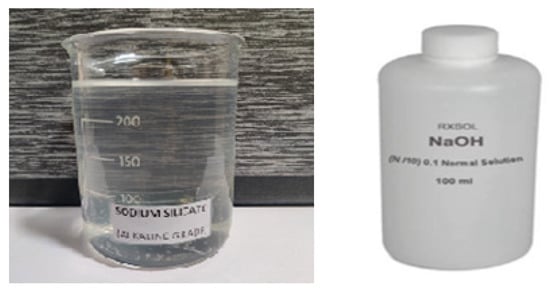
Figure 1.
Sodium silicate and sodium hydroxide used as alkaline solution.
E-glass fibers from industry were purchased and used in concrete. Different properties of glass fibers are shown in Table 5 [31].

Table 5.
Physical properties of glass fibers.
The overall methodology required for the research is summarized below:
- Collection of fly ash material from industrial (thermal power plant class F) used as filler material for concrete
- Collection of glass fibers from industry
- Casting of conventional concrete cubes and concrete cylinders
- Casting of geopolymer concrete with combinations of cement and fly ash as 15% and 85%, respectively
- Use of NaOH or KOH and sodium silicate or potassium silicate as alkaline solution for geopolymerization
- Casting of glass-fiber-“reinforced” concrete cubes and cylinders
- Curing of casted samples of concrete for 7, 14, 21, and, 28 days
- Testing of concrete cubes and cylinders in compressing testing machines
- Comparison of failure modes of all concrete samples with or without geopolymer and glass fibers
4. Experimental Program
Concrete mixes were prepared from the chosen material as per ACI mix design and casted in the laboratory. The ratio for the preparation of concrete mixes was equal to 1:2:4, with the water to cement ratio used being 0.50. For alkaline medium for geopolymer concrete, quantities of sodium hydroxide and sodium silicate were added. Glass fibers in the range of 3%, 6%, and 10% by weight of cement were also added in concrete. Concrete cube mold of size 150 × 150 × 150 mm and cylinders having size 150 × 300 mm were filled with materials in 3 layers with compacting each layer by 25 strokes. Total number of samples casted for all types of tests for geopolymer concrete along with standards are presented in Table 6. Similarly, total number of samples casted for all types of tests for glass fiber concrete along with standards are presented in Table 7.

Table 6.
Testing details for geopolymer concrete, adapted standard, and number of samples prepared.

Table 7.
Testing details for glass fiber concrete, adapted standard, and number of samples prepared.
4.1. Preparation of Liquids
The sodium hydroxide (NaOH) solids were dissolved in water to make the solution. The sodium silicate solution and the sodium hydroxide solution were mixed at least one day before use to prepare the alkaline activator. On the day of casting of the specimens, the alkaline activator was mixed with the super plasticizer SP-675 at dosage rate of 2% by weight of cement to gain the proper workability of fresh concrete mix and the extra water (if any) to prepare the activator component of the mixture.
4.2. Casting of Concrete Cubes and Cylinders
The fly ash and the aggregates were first mixed in the laboratory concrete pan mixer for about four minutes. Then, the liquid component of the mixture was added to the dry materials and the mixing continued for about a further 5 min to manufacture the fresh concrete. The fresh concrete was casted into the molds. For compaction of the specimens, each layer was given 25 manual strokes using a temping rod. Figure 2 shows the casted concrete cubes and cylinders with or without geopolymer and glass fiber materials.
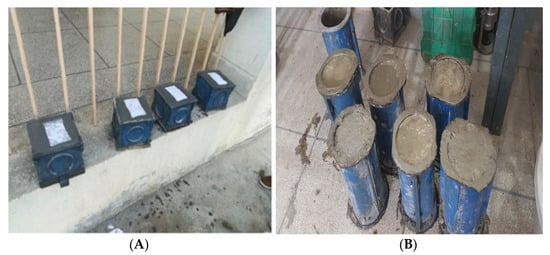
Figure 2.
(A) Casted concrete cubes with or without geopolymer materials; (B) casted concrete cylinders with or without glass fiber material.
The casted concrete specimens in cube and cylindrical moulds with or without geopolymer and glass fibers were allowed to set for 24 h. After 24 h, the specimens were removed from the moulds and kept in a curing tank. The curing process was continued for 7, 14, 21, and 28 days. After completion of curing periods, the cubes were removed from curing tank and tested for compressive strength.
5. Results and Discussion
Three types of tests were performed on concrete samples with or without geopolymer and glass fiber materials. One was the workability test on fresh concrete samples, while the others were compressive strength and split tensile strength tests on all concrete cubes and cylinders. The results of all the types of tests are presented in the following sections.
5.1. Workability
The workability test on all the concrete samples was performed by slump cone apparatus as per ASTMC143/C143M [65]. From the workability test, it was revealed that the workability of concrete having geopolymer was better than ordinary Portland cement concrete. The reason for the good workability was the fluidity of geopolymer concrete because of alkaline media of NaOH and Na2SiO3. The combination of water and alkaline liquid caused fresh concrete to become a workable mix; hence, the placement and finishing of geopolymer concrete was better than ordinary Portland cement concrete. On the other hand, the workability of glass fiber concrete reduced with increasing the content of glass fibers; this is because glass fiber concrete had less fluidity and free water as compared to ordinary concrete and concrete having geopolymer material. The results of workability are presented in Figure 3.
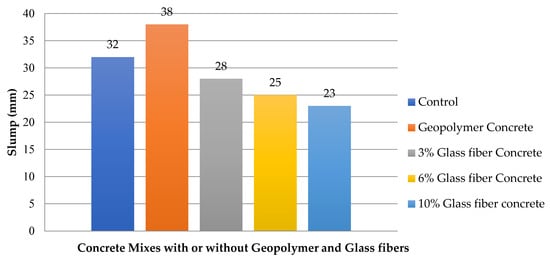
Figure 3.
Results of workability test of fresh concrete samples with or without geopolymer and glass fiber materials.
5.2. Mechanical Properties
The study also covers the compressive strength and split tensile strength analysis of all the concrete samples.
5.2.1. Compressive Strength
The compressive strength test on all the concrete cubes was performed as per ASTMC39/C39M [66]. A compression testing machine of 3000 kN capacity was used for the compressive strength testing of concrete cubes and cylinders, as shown in Figure 4.
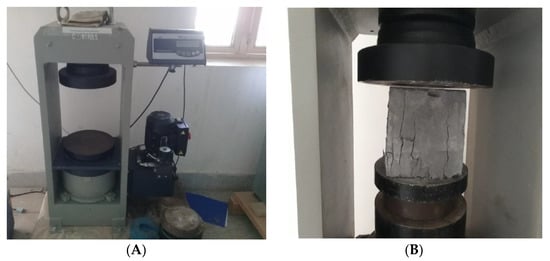
Figure 4.
(A) Compression testing machine for compressive strength test of concrete cubes and cylinders; (B) failed concrete cube after compression test.
The results of the compressive strength test of all the concrete cubes with or without geopolymer material are shown in Figure 5. From the test results, it was concluded that concrete having geopolymer material had lesser compressive strength than ordinary Portland cement concrete. The reason for the reduced strength of geopolymer concrete was more fluidity, the presence of super plasticizer SP-675, and water curing of geopolymer concrete. The concrete having geopolymer and super plasticizer SP-675 was a more workable mix than ordinary Portland cement concrete having no super plasticizer. More workability leads to decreased strength of concrete. The second reason for the decreased strength was the water curing of geopolymer concrete. Water curing has less of an effect on the strength development of geopolymer concrete as compared to ordinary Portland cement concrete [15].
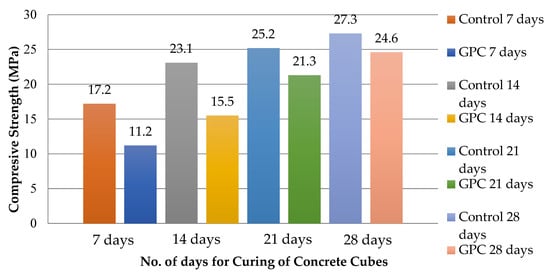
Figure 5.
Comparison of compressive strength of ordinary Portland cement concrete and concrete having geopolymer.
The compressive strength values of concrete cubes with or without glass fibers are presented in Figure 6. From Figure 6, it was concluded that the compressive strength of concrete decreased with an increase in the quantity of glass fibers, and the strength was minimum at 10% glass fiber content. The reason for the decrease in compressive strength of concrete with increasing glass fiber content is the lack of workability due to the higher surface area, which causes resistance to the flow of concrete. The optimum percentage of glass fibers for improved strength is 2% [68].
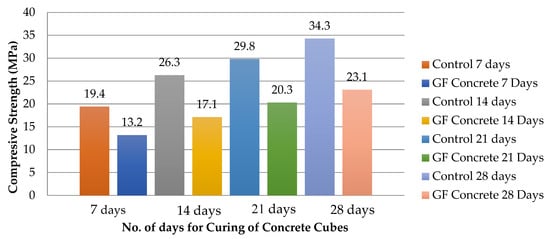
Figure 6.
Comparison of compressive strength of ordinary Portland cement concrete and concrete having glass fibers.
5.2.2. Split Tensile Strength
The split tensile strength test on all the concrete cylinders was performed as per ASTMC496/C496M-17 [67]. A compression testing machine of 3000 kN capacity was used for the split tensile strength test of concrete cylinders, as shown in Figure 7. From the test results, it was concluded that concrete having geopolymer and glass fibers had lesser split tensile strength values as compared to conventional concrete. The reason for the reduced split tensile strength of concrete having geopolymer was more fluidity and alkaline medium, while the reason for the reduced strength of concrete having glass fibers was more segregation in the concrete. The strength comparison of concrete having geopolymer and glass fibers materials with conventional concrete is presented in Figure 8 and Figure 9, respectively.
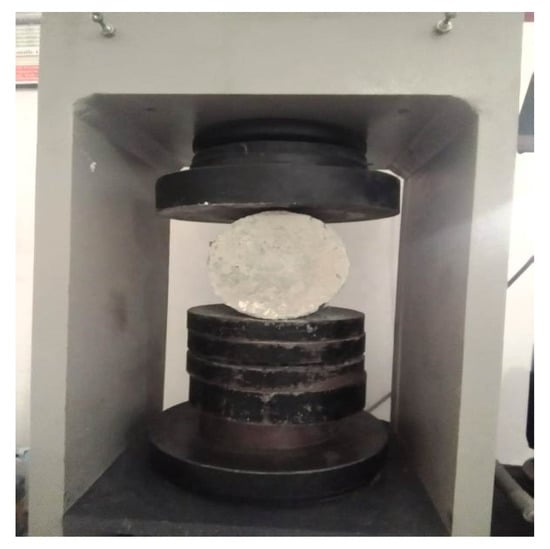
Figure 7.
Placement of concrete cylinder in compression testing machine for split tensile strength test.
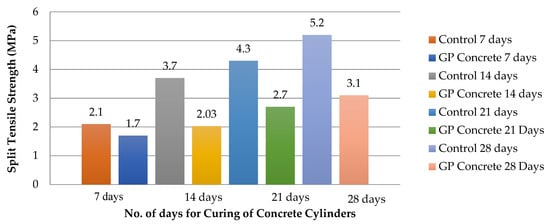
Figure 8.
Comparison of split tensile strength of ordinary concrete and concrete having geopolymer material.
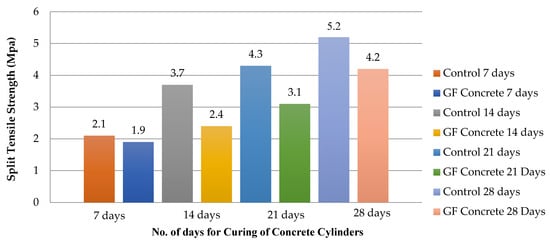
Figure 9.
Comparison of split tensile strength of ordinary concrete and concrete having glass fibers.
5.2.3. Failure Pattern of Concrete Cubes and Cylinders
Figure 10 and Figure 11 show the failure pattern of concrete cubes and cylinders having geopolymer and glass fiber materials, which was sudden and brittle. Due to the use of super plasticizer SP-675, poor bonding between cement paste and geopolymer material, and a lack of performance of glass fibers due to lesser workability, the strength of geopolymer and glass fiber concrete decreased, resulting in lesser strength as compared to conventional concrete samples.
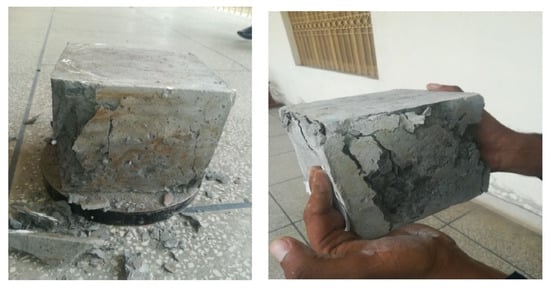
Figure 10.
Failure pattern of geopolymer and glass fiber concrete cubes after compression test.

Figure 11.
Failure pattern of geopolymer and glass fiber concrete cylinders after split tensile strength test.
5.3. Statistical Correlation between Different Properties of Concrete Having Geopolymer and Glass Fibers
Different experimental parameters are correlated with statistical correlation, as conducted in the past [69]. In these correlations, a relationship is established to show the effect of one parameter on the dependent variable. The proportion of variance of the dependent variable to measure the confidence of the correlation is determined by a coefficient of determination named R2. The development of regression models was completed to indicate the same work by A. Ahmad, M. Adil, A. Khalil, and M. Rahman [70] on concrete having cardboard for measuring its density and thermal conductivity. The value of R2 for that regression model was developed greater than 0.95. A new correlation was developed by A. Meddah, M. Beddar, and A. Bali [71] for measuring the strength loss of concrete pavement due to the increase in the quantity of rubber content. Khatib, J., Ramadan, R., Ghanem, H., and Elkordi [72] concluded that the value of R2 for the correlation between compressive strength and chemical shrinkage between cement paste and mortar at different curing ages was 0.75, which was found to be less than the R2 value for correlation between compressive strength and UPV, which was 0.82. Khatib J., Ramadan R., Ghanem, H., and Elkordi A [73] concluded that a positive correlation existed between chemical shrinkage and both autogenous and drying shrinkage. On the other hand, a negative correlation existed between chemical and drying shrinkage.
On the basis of the strength values obtained from two types of tests, different regression models have been developed between compressive strength and split tensile strength values of concrete having geopolymer material and glass fiber materials, as shown in Figure 12 and Figure 13, respectively.
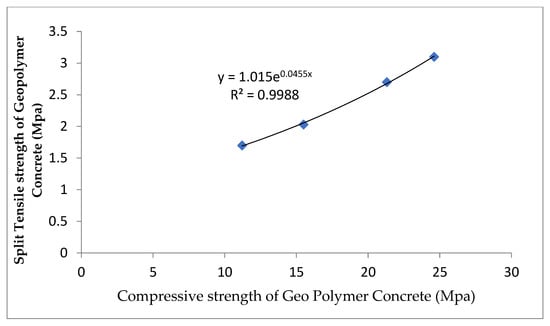
Figure 12.
Correlation between compressive strength and split tensile strength values of geopolymer.
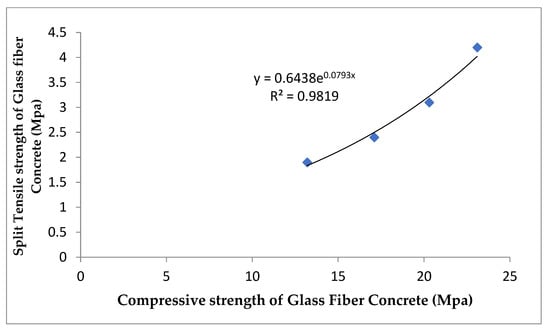
Figure 13.
Correlation between compressive strength and split tensile strength values of glass fiber concrete.
From Figure 12, a relationship was developed between compressive strength and split tensile strength values of geopolymer concrete as shown in Equation (1). The value of R2 is 0.998.
From Figure 13, a relationship was developed between compressive strength and split tensile strength values of glass fiber concrete as shown in Equation (1). The value of R2 is 0.982.
6. Conclusions and Recommendations
Based on the test results, the following conclusions are drawn:
- In this study, workability, compressive strength, and split tensile strength of fly-ash-based geopolymer concrete with alkaline solution and concrete having glass fibers added by weight of cement were investigated.
- The workability of geopolymer concrete was found to be higher than conventional concrete and concrete having glass fibers because of more fluidity and the alkaline solution of sodium silicate and sodium hydroxide. The workability values of glass fiber concrete decreased with an increase in the content of glass fibers due to the reason of an increase in the segregation of concrete and resistance to the flow of concrete [68].
- The compressive strength values decreased with an increase in the content of geopolymer and glass fiber contents in concrete due to the reason of more alkalinity of geopolymer concrete and an increase in the segregation of concrete with an increase in the content of glass fibers. The optimum value of glass fiber content in concrete is found as 2% [68]. As far as the compressive strength of geopolymer concrete, it depends on the nature of curing as oven curing is found suitable for geopolymer concrete as compared to water curing for obtaining better strength [19].
- The split tensile strength values of concrete having geopolymer and glass fibers also decreased with an increase in the amount of geopolymer and glass fiber content in concrete. The optimum value of glass fiber in concrete is 1.5% for the improvement in the flexural strength of concrete [68]. The nature of curing also has a significant effect on the split tensile strength of concrete, and oven curing is preferred over water curing [19].
- Some testing work on concrete samples having fly ash and glass fiber was also conducted at the initial level of testing, and the results showed that two different materials having different effects on the same concrete mix as fly ash content was effective for increasing the workability of the concrete mix, while glass fibers were found to reduce the workability of concrete due to resistance to the flow of concrete, and concrete having glass fibers showed a lack of performance as compared to conventional concrete. From past work, it was found that there was no significant effect of fly ash and glass fibers on the compressive strength of concrete when used in combined form, while 15% FA and 0.17% GF provide good results in terms of the split tensile strength of concrete [74].
In continuation of the present research study, the following research works related to fly-ash-based geopolymer and glass fiber concrete may be carried out in the future.
- The effect of fly ash from different sources on the compressive strength of geopolymer concrete needs to be explored.
- There is a need to investigate the effect of other hydroxide solutions, such as barium hydroxide, lithium hydroxide, and magnesium hydroxide, in the compressive strength of geopolymer concrete.
- Durability studies of geopolymer concrete need to be investigated in the future.
- Different grades of concrete with different water to cement ratios may also be investigated with geopolymer and glass fiber materials.
- The effects of different admixtures on geopolymer and glass fiber concrete need to be investigated in future research work.
Author Contributions
Conceptualization, S.N.A.; Data curation, M.I.Q. and M.A.U.R.T.; Formal analysis, S.N.A. and M.A.U.R.T.; Investigation, S.N.A., M.I.Q., M.M.A. and M.A.U.R.T.; Methodology, S.N.A., A.Z. and M.A.U.R.T.; Resources, M.I.Q. and A.Z.; Software, M.M.A.; Supervision, M.I.Q.; Validation, M.M.A.; Writing—original draft, M.I.Q., A.Z. and M.A.U.R.T.; Writing—review & editing, M.A.U.R.T. All authors have read and agreed to the published version of the manuscript.
Funding
This research received no external funding.
Institutional Review Board Statement
Not applicable.
Informed Consent Statement
Not applicable.
Data Availability Statement
Not applicable.
Conflicts of Interest
The authors declare no conflict of interest.
References
- Garside, M. Global Cement Production 1995–2021. Available online: https://www.statista.com/statistics/1087115/global-cement-production-volume/ (accessed on 1 April 2022).
- Rubenstein, M. Emissions from the Cement Industry. 9 May 2022. Available online: https://news.climate.columbia.edu/2012/05/09/emissions-from-the-cement-industry/ (accessed on 1 April 2022).
- Kesharwani, K.C.; Biswas, A.K.; Chaurasiya, A.; Rabbani, A. Experimental study on use of Fly Ash in Concrete. Int. Res. J. Eng. Technol. 2017, 5, 1527–1530. [Google Scholar]
- Mo, K.H.; Alengaram, U.J.; Jumaat, M.Z. Structural performance of reinforced geopolymer concrete members: A review. Constr. Build. Mater. 2016, 120, 251–264. [Google Scholar] [CrossRef]
- Lloyd, N.; Rangan, V. Geopolymer Concrete—Sustainable Cementless concrete. In Proceedings of the 10th ACI International Conference, Seville, Spain, 12 October 2009; pp. 33–53. [Google Scholar]
- Wong, L.S. Durability performance of Geopolymer concrete: A review. Polymers 2022, 14, 868. [Google Scholar] [CrossRef]
- Bajpai, R.; Chaudhary, K.; Srivastava, A.; Sangwan, K.S.; Singh, M. Environmental Impact assessment of fly ash and silica fume based geopolymer concrete. J. Clean. Prod. 2020, 254, 120–147. [Google Scholar] [CrossRef]
- Ganesan, N.; Abraham, R.; Raj, S.D. Durability characteristics of steel fiber reinforced Geopolymer concrete. Constr. Build. Mater. 2015, 93, 471–476. [Google Scholar] [CrossRef]
- Mirza, F.A.; Soroushian, P. Effects of alkali resistant glass fiber reinforcement on crack and temperature resistance of light weight concrete. Cem. Concr. Compos. 2002, 24, 223–227. [Google Scholar] [CrossRef]
- Ali, B.; Qureshi, L.A.; Raza, A.; Nawaz, M.A.; Rehman, S.U.; Rashid, M.U. Influence of Glass fibers on Mechanical properties of concrete with Recycled coarse aggregates. Civ. Eng. J. 2019, 5, 1007–1019. [Google Scholar] [CrossRef]
- Tobbi, H.; Farghaly, A.S.; Benmokrane, B. Concrete Columns Reinforced Longitudinally and Transversally with Glass Fiber-Reinforced Polymer Bars. ACI Struct. J. 2012, 109, 551–558. [Google Scholar]
- Avci, A.; Arikan, H.; Akdemir, A. Fracture behavior of glass fiber polymer composite. Cem. Concr. Res. 2004, 34, 429–434. [Google Scholar] [CrossRef]
- Hemalatha, S.; Rose, A.L. An experimental study on Glass fiber reinforced concrete. Int. Res. J. Eng. Technol. 2016, 3, 2285–2289. [Google Scholar]
- Jedulius, G. Experimental Study on Glass Fiber Concrete. Int. J. Eng. Res. Technol. 2016, 4, 1–10. [Google Scholar]
- Xiaochuna, Q.; Xiaoming, L.; Xiaopeia, C. The applicability of alkaline-resistant glass fiber in cement mortar of road pavement: Corrosion mechanism and performance analysis. Int. J. Pavement Res. Technol. 2017, 10, 536–544. [Google Scholar] [CrossRef]
- Aleem, M.I.A.; Arumairaj, P.D. Geopolymer concrete: A Review. Int. J. Eng. Sci. Emerg. Technol. 2012, 1, 118–122. [Google Scholar] [CrossRef]
- Sanni, S.H.; Khadiranaikar, R.B. Performance of Geopolymer Concrete under Severe Environmental Conditions. Int. J. Civ. Struct. Eng. 2012, 3, 396. [Google Scholar]
- Yasir, S.; Iftekar, G. Study of Properties of Fly Ash Based Geopolymer Concrete. Int. J. Eng. Res. 2015, 3, 1–10. [Google Scholar]
- Jamdade, P.K.; Kawade, U.R. Evaluate Strength of Geopolymer Concrete by Using Oven Curing. IOSR J. Mech. Civ. Eng. 2014, 11, 63–66. [Google Scholar] [CrossRef]
- Jaydeep, S.; Chakravarthy, B.J. Study on Fly Ash Based Geopolymer Concrete Using Admixtures. Int. J. Eng. Trends Technol. 2013, 4, 2231–5381. [Google Scholar]
- Joseph, B.; Mathew, G. Influence of aggregate content on the behavior of fly ash based geopolymer concrete. Sci. Iran. 2012, 19, 1188–1194. [Google Scholar] [CrossRef]
- Singh, B.; Ishwarya, G.; Gupta, M.; Bhattacharyya, S.K. Geopolymer Concrete, A review of some recent development. Constr. Build. Mater. 2015, 85, 78–90. [Google Scholar] [CrossRef]
- Hardjito, D.; Wallah, S.E.; Sumajouw, D.M.J.; Rangan, B.V. On the development of Fly Ash based Geopolymer Concrete. ACI Mater. J. 2004, 101, 467–472. [Google Scholar]
- Rangan, B.V. Geopolymer Concrete for Environmental Protection. Indian Concr. J. 2014, 88, 41–59. [Google Scholar]
- Sarkar, P. Bond Strengths of Geopolymer and Cement Concrete; School of Civil and Mechanical Engineering: Perth, Australia, 2010; pp. 1–9. [Google Scholar]
- Almutairi, A.L.; Tayeh, B.A.; Adesina, A.; Isleem, H.F.; Zeyadef, A.M. Potential application of Geopolymer concrete in construction: A review. Case Stud. Constr. Mater. 2021, 15, 1–20. [Google Scholar] [CrossRef]
- Van Chanh, N.; Trung, B.D.; Van Tuan, D. Recent research on Geopolymer Concrete. In Proceedings of the 3rd ACF International Conference-ACF/VCA, Ho Chi Minh City, Vietnam, 11–13 November 2008; pp. 235–241. [Google Scholar]
- Aldred, J.; Day, J. Is Geopolymer Concrete is a suitable alternative to Traditional Concrete. In Proceedings of the 37th Conference on Our World in Concrete & Structures, Singapore, 29–31 August 2012; pp. 1–14. [Google Scholar]
- Lloyd, N.A.; Rangan, B.V. Geopolymer Concrete: A review of development and Opportunities. In Proceedings of the 35th Conference on Our World in Concrete & Structures, Singapore, 25–27 August 2010; pp. 1–10. [Google Scholar]
- Diaz-Loya, E.I.; Allouche, E.N.; Vaidya, S. Mechanical Properties of Fly Ash based Geopolymer Concrete. ACI Mater. J. 2011, 108, 300. [Google Scholar]
- Parathi, S.; Nagarajan, P.; Pallikkar, S.A. Ecofriendly Geopolymer Concrete: A comprehensive review. Clean Technol. Environ. Policy 2021, 23, 1701–1713. [Google Scholar] [CrossRef]
- Nurruddin, M.F.; Sani, H.; Mohammed, B.S.; Shaaban, I. Methods of curing geopolymer concrete: A review. Int. J. Adv. Appl. Sci. 2018, 5, 31–36. [Google Scholar] [CrossRef]
- Olivia, M.; Nikraz, H.R. Strength and Water Penetrability of Fly Ash Geopolymer Concrete. Asian Res. Publ. Netw. 2011, 6, 70–78. [Google Scholar]
- Laskar, A.I.; Bhattacharjee, R. Effect of Plasticizer and Superplasticizer on Workability of Fly Ash Based Geopolymer Concrete. In Proceedings of the International Conference on Advances in Architecture and Civil Engineering, Karnataka, India, 21–23 June 2012; Volume 2, ISBN 978-93-82338. [Google Scholar]
- Davidovits, J. Geopolymer Chemistry and Properties. In Proceedings of the Geopolymer ’88, First European Conference on Soft Mineralurgy, Compiegne, France, 1–3 June 1988. [Google Scholar]
- Xu, H.; Deventer, J.S.J. The Geo polymerization of Natural Alumino-Silicates. In Proceedings of the Geopolymer ’99 International Conference, Saint-Quentin, France, 30 June–2 July 1999. [Google Scholar]
- Shah, C.K.; Parikh, A.R.; Parmar, K.J. Study of Strength Parameters and durability of Fly ash based Geopolymer Concrete. Indian J. Res. 2014, 3, 530–545. [Google Scholar] [CrossRef]
- Hardjito, D.; Wallah, S.E.; Sumajouw, D.M.J.; Rangan, B.V. Factors influencing the compressive strength of Fly Ash based Geopolymer Concrete. Civ. Eng. Dimens. 2004, 6, 88–93. [Google Scholar]
- Luhar, S.; Nicolaides, D.; Luhar, I. Fire Resistance behavior of Geopolymer Concrete: A review. Buildings 2021, 11, 82. [Google Scholar] [CrossRef]
- Chowdhury, S.; Mohapatra, S.; Gaur, A.; Dwivedi, G.; Soni, A. Study of Various properties of Geopolymer concrete: A review. Mater. Today’s Proc. 2021, 46, 5687–5695. [Google Scholar] [CrossRef]
- Thakur, P.; Singh, K. A Review on Geopolymer Concrete. IJRET 2018, 3, 1765–1769. [Google Scholar]
- Al Bakri, A.M.M.; Kamarudin, H.; Bnhussain, M.; Nizar, I.K.; Mastura, W.I.W. Mechanism and Chemical Reaction of Fly Ash Geopolymer Cement—A Review. J. Asian Sci. Res. 2011, 1, 247–253. [Google Scholar]
- Murthy, Y.I.; Sharda, A.; Jain, G. Performance of Glass Fiber Reinforced Concrete. Int. J. Eng. Innov. Technol. 2012, 1, 246–248. [Google Scholar]
- Ghugal, Y.M.; Deshmukh, S.B. Performance of Alkali-resistant Glass Fiber Reinforced Concrete. J. Reinf. Plast. Compos. 2006, 25, 617–630. [Google Scholar] [CrossRef]
- Shukla, A.K.; Nagar, B. Effect of Chopped Glass Fibers on The Strength of Concrete Tiles. World J. Res. Rev. WJRR 2019, 9, 1–4. [Google Scholar]
- Bishetti, P.; Ameersohel; Basavannevva, N.; Suhas, M.; Veergangadhar, A. Glass fiber reinforced concrete. SSRG Int. J. Civ. Eng. 2019, 6, 23–26. [Google Scholar] [CrossRef]
- Deshmukh, S.H.; Bhusari, J.P.; Zende, A.M. Effect of Glass Fibers on Ordinary Portland cement Concrete. IOSR J. Eng. 2012, 2, 1308–1312. [Google Scholar]
- İskender, M.; Karasu, B. Glass Fiber reinforced concrete. El-Cezerî J. Sci. Eng. 2018, 5, 136–162. [Google Scholar]
- Kumar, J.D.C.; Abhilash, G.V.S.; Khan, P.K.; Sai, G.M.; Ram, V.T. Experimental studies on glass fiber concrete. Am. J. Eng. Res. AJER 2016, 5, 100–104. [Google Scholar]
- Sathishkumar, T.P.; Satheeshkumar, S.; Naveen, J. Glass fiber-reinforced polymer composites—A review. J. Reinf. Plast. Compos. 2014, 33, 1258–1275. [Google Scholar] [CrossRef]
- Gornale, A.; Quadri, S.I.; Quadri, S.M.; Ali, S.M.A.; Hussaini, S.S. Strength aspects of glass fiber reinforced concrete. Int. J. Sci. Eng. Res. 2012, 3, 1–5. [Google Scholar]
- Chawla, K.; Tekwani, B. Studies of Glass Fiber Reinforced Composites. Int. J. Struct. Civ. Eng. Res. 2013, 2, 176–182. [Google Scholar]
- Moghadam, M.A.; Izadifard, R.A. Effects of steel and glass fibers on mechanical and durability properties of concrete exposed to high temperatures. Fire Saf. J. 2020, 13, 1–10. [Google Scholar] [CrossRef]
- Lv, Y.; Cheng, H.-M.; Ma, Z.-G. Fatigue performance of glass fiber reinforced concrete in flexure. Procedia Eng. 2012, 31, 550–556. [Google Scholar] [CrossRef][Green Version]
- Wang, W.-C.; Wang, H.-Y.; Chang, K.H.; Wang, S.-Y. Effect of High Temperature on the strength and Thermal conductivity of glass fiber concrete. Constr. Build. Mater. 2020, 245, 1–12. [Google Scholar] [CrossRef]
- Praburanganathan, S.; Sudharsan, N.; Bharath Simha Reddy, Y. Force-Deformation Study on Glass Fiber Reinforced Concrete Slab Incorporating Waste Paper. Hindwai Adv. Civ. Eng. 2022, 2022, 1–10. [Google Scholar] [CrossRef]
- Ruben, N.; Venkatesh, C.; Durga, C.S.S.; Chand, M.S.R. Comprehensive study on performance of glass fiber based concrete. Innov. Infrastruct. Solut. 2021, 6, 1–11. [Google Scholar] [CrossRef]
- Ali, B.; Qureshi, L.A. Combined effect of fly ash and glass fibers on mechanical performance of concrete. NED Univ. J. Res. 2018, 15, 91–100. [Google Scholar]
- Reis, J.M.L.; Ferreira, A.J.M. Fracture Behavior of glass fiber reinforced polymer concrete. Polym. Test. 2003, 22, 149–153. [Google Scholar] [CrossRef]
- Prasad, M.L.V.; Rathish, K.P. Strength Studies on Glass Fiber Reinforced Recycled Aggregate Concrete. Asian J. Civ. Eng. Build. Hous. 2007, 8, 677–690. [Google Scholar]
- Ali, S.A.; Malleswar, M. Experimental study on Glass fiber reinforced moderate deep beams. Int. J. Sci. Eng. Technol. Res. 2016, 5, 728–732. [Google Scholar]
- Alsayed, S.H.; Al-Salloum, Y.A.; Almusallam, T.H.; Amjad, M.A. Concrete Columns Reinforced by Glass Fiber Reinforced Polymer Rods. Am. Concr. Inst. 1999, 188, 103–112. [Google Scholar]
- Tucker, D.; Ethridge, E. Production of Glass Fibers for Reinforcing Lunar Concrete; Aerospace Research Central, American Institute of Aeronautics and Astronautics: Reston, VA, USA, 2006; pp. 1–10. [Google Scholar]
- Soong, W.H.; Raghavan, J.; Rizkalla, S.H. Fundamental mechanisms of bonding of glass fiber reinforced polymer reinforcement to concrete. Constr. Build. Mater. 2011, 25, 2813–2821. [Google Scholar] [CrossRef]
- ASTM C143/C143M; Standard Test Method for Slump of Hydraulic-Cement Concrete, ASTM Stand. ASTM International: West Conshohocken, PA, USA, 2015.
- ASTM C39/C39M; Standard Test Method for Compressive Strength of Cylindrical Concrete Specimens. ASTM International: West Conshohocken, PA, USA, 2018.
- ASTM C496/C496M-17; Standard Test Method for Splitting Tensile Strength of Cylindrical Concrete Specimens. ASTM International: West Conshohocken, PA, USA, 2017.
- Ahmad, J.; González-Lezcano, R.A.; Majdi, A.; Kahla, N.B.; Deifalla, A.F.; El-Shorbagy, M.A. Glass fiber reinforced concrete: An overview on Mechanical, Durability and Microstructure analysis. Materials 2022, 15, 5111. [Google Scholar] [CrossRef]
- Ramezanianpour, A.A.; Jovein, H.B. Influence of metakaolinas supplementary cementing material on strength and durability of concretes. Construct. Build. Mater. 2012, 30, 470–479. [Google Scholar] [CrossRef]
- Ahmad, A.; Adil, M.; Khalil, A.; Rahman, M. Mechanical properties and durability of board concrete blocks prepared from recycled cardboard. J. Build. Eng. 2021, 33, 101644. [Google Scholar] [CrossRef]
- Meddah, A.; Beddar, M.; Bali, A. Use of shredded rubber tire aggregates for roller compacted concrete pavement. J. Clean. Prod. 2014, 72, 187–192. [Google Scholar] [CrossRef]
- Khatib, J.; Ramadan, R.; Ghanem, H.; Elkordi, A. Effect of using limestone fines on the chemical shrinkage of pastes and mortars. Environ. Sci. Pollut. Res. 2022, 29, 1–21. [Google Scholar] [CrossRef]
- Khatib, J.; Ramadan, R.; Ghanem, H.; Elkordi, A. Volume Stability of Pastes Containing Limestone Fines. Buildings 2021, 11, 366. [Google Scholar] [CrossRef]
- Shwetha, P.C.; Praveena, K.; Ajith, B.T.; Chandrashekhar, A. Experimental study on the partial replacement of cement by Fly Ash with Glass fiber reinforcement. Int. J. Eng. Res. Technol. 2015, 4, 1205–1211. [Google Scholar] [CrossRef]
Publisher’s Note: MDPI stays neutral with regard to jurisdictional claims in published maps and institutional affiliations. |
© 2022 by the authors. Licensee MDPI, Basel, Switzerland. This article is an open access article distributed under the terms and conditions of the Creative Commons Attribution (CC BY) license (https://creativecommons.org/licenses/by/4.0/).